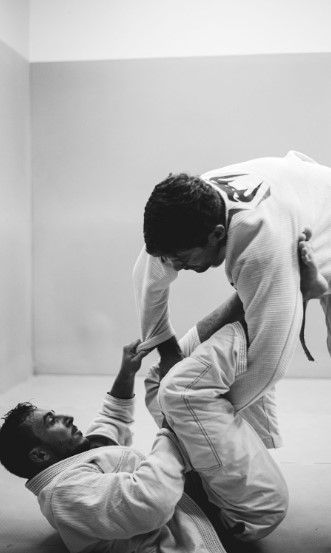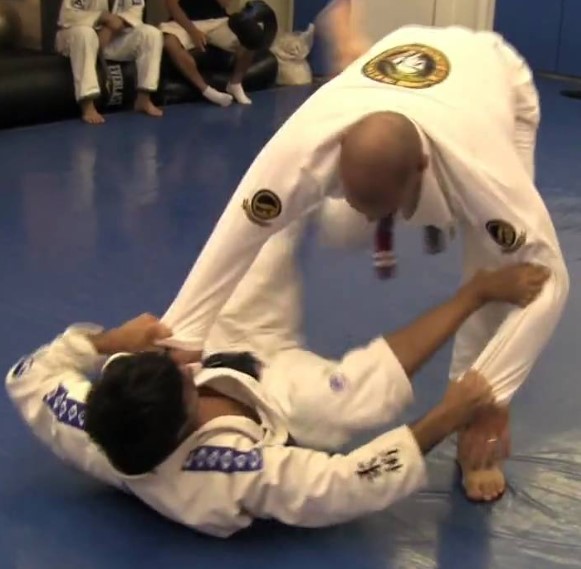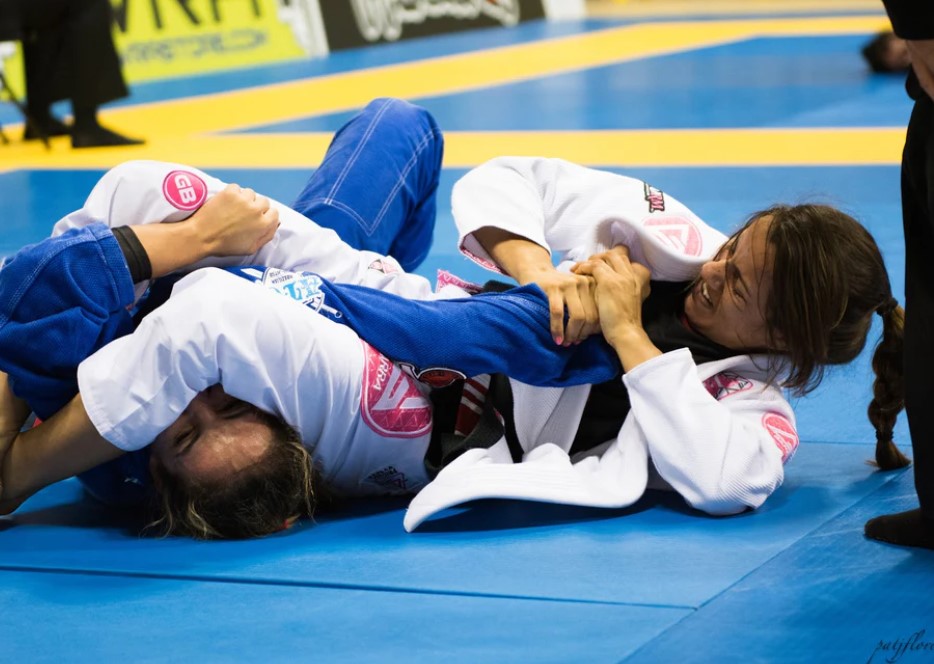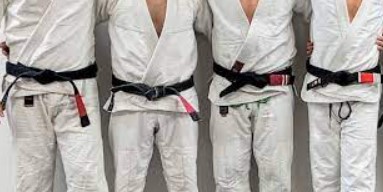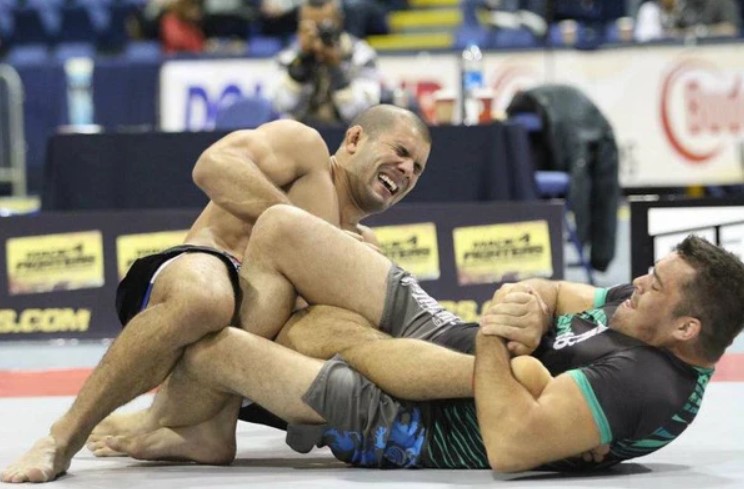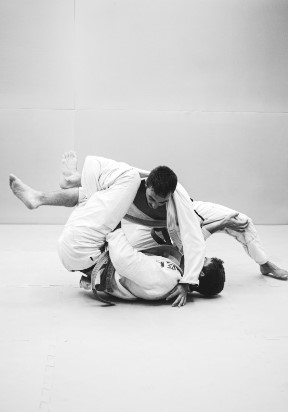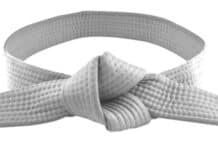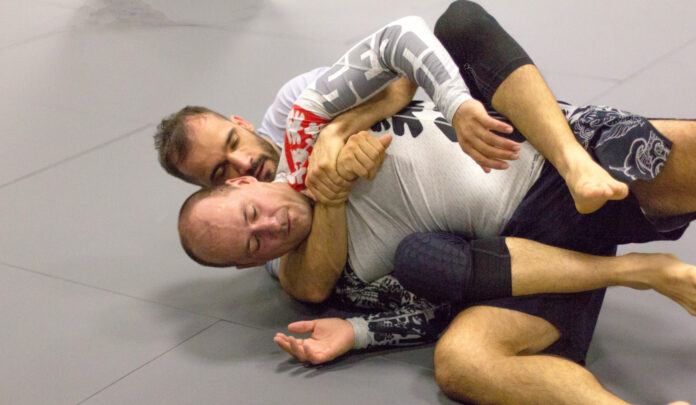
Whether you’re a fan of MMA or martial arts in general, you’ve probably heard mention of this grappling art.
If you’re unfamiliar with it, you’ve also probably found yourself asking “what is Jiu-Jitsu?”
Look no further, because we’re here to tell you all about this wonderful martial art.
From its origins and techniques to the benefits of practicing the sport and a glossary of terms. This article will cover everything you need to know about Jiu-Jitsu.
What is Jiu-Jitsu?
First and foremost, we need to cover what Jiu-Jitsu is, and what it accomplishes.
Commonly referred to as Brazilian Jiu-Jitsu or just BJJ, Jiu-Jitsu is primarily a ground-based martial art. It focuses on grappling with an opponent to maintain control of them.
Where it differentiates from many other martial arts, like karate or boxing, is that it doesn’t involve any striking.
The goal of Jiu-Jitsu is to exert control over your opponent, eventually leading them to submit, or tap out.
It is much more similar to other grappling arts, such as wrestling or judo. Where it differs from these is that it is primarily based on the ground.
Jiu-Jitsu also differentiates itself from other martial arts through its complexity and emphasis on live sparring – A.K.A. ‘rolling’.
Largely considered the most cerebral martial art, Jiu-Jitsu has hundreds of techniques that take years to truly master.
These techniques are also genuinely being battle tested against training partners. Most schools place a heavy emphasis on live sparring or ‘rolling’ as it’s usually called in Jiu-Jitsu.
Jiu-Jitsu, aside from being a fun and competitive sport, is also a very viable form of self-defense.
Studies show that approximately 85% of street fights end up on the ground. Therefore, it’s vital to know how to defend yourself in these positions.
It is also one of the most defensive martial arts. Jiu-Jitsu allows you to keep yourself safe in a physical altercation without inflicting unnecessary damage to another person.
Origins of Jiu-Jitsu
While the true origins of Jiu-Jitsu likely trace back 1000s of years, what we refer to today as Brazilian Jiu-Jitsu only goes back to the 1910s.
Japanese judoka Mitsuyo Maeda was sent by his master, and the founder of judo, Kano Jigoro, to travel abroad and demonstrate his art to the world. This eventually led him to Brazil in 1914 where he began teaching Carlos Gracie.
Carlos’ brothers soon began learning from Maeda as well. His brother, Helio Gracie, was the smallest of the group and did not have the required strength to perform many of the throws being taught. This is what led to him focusing on the ground-fighting aspects of the sport, which relied more on leverage than strength.
And thus, Brazilian Jiu-Jitsu was born.
The Gracies went on to continue developing the sport, which slowly rose in fame over the years. This was largely due to a series of videotapes titled “Gracie in Action”. These videos showed the family using the art to great success against a wide variety of skilled opponents.
The sport truly reached prominence in 1993 with the formation of the UFC. The first, second, and fourth of the events saw Royce Gracie use Jiu-Jitsu to achieve victory against significantly larger opponents.
The sport has gone on to be known for its effectiveness when used by smaller people. It is one of the few martial arts where pure technicality tends to best athleticism.
How does Jiu-Jitsu Work?
Jiu-Jitsu works by maintaining control over an opponent, eventually leading them to submit. Often described as ‘human chess’, Jiu-Jitsu is an incredibly complex and cerebral sport that demands incredible skill from its athletes.
There are many different positions in Jiu-Jitsu that form a sort of hierarchy of control. Each position has its unique advantages and disadvantages. If you are in a disadvantageous position, it should be your top priority to first survive, and then escape to a more advantageous one.
Once you are in a dominant position, you may begin looking for submissions. These are specific holds – usually around a joint or the neck – that are used to make your opponent ‘tap out’.
There are dozens of submissions in Jiu-Jitsu, with some of the most common being the rear naked choke, the arm bar, and the kimura lock.
In most Jiu-Jitsu competitions, points are awarded for maintaining dominant positions. If there is no submission to decide the outcome, a decision is made based on who held the more dominant position throughout the match.
What are the Different Belt Rankings in Jiu-Jitsu?
Jiu-Jitsu has a total of 5 different belts progressing from white to black. Each belt signifies a different point in your training journey.
The time spent at each belt varies widely depending on your coach’s standards, the amount you train, and whatever is going on in your life.
Black belt won’t come as fast as you think unless you’re someone from this list, but you know you earned it and for a lot of Jiu-Jitsu practitioners, it’s something precious. It takes an average of 10 to 15 years of consistent training to earn a black belt.
White Belt
The first belt in Jiu-Jitsu. This is where you spend your time as a fresh beginner.
The primary goal for any white belt should be learning to survive and escape from the worst positions in the sport.
This is also where the vast majority of people give up on Jiu-Jitsu. It is estimated only 3 out of every 10 white belts will make it to the next rank.
Blue Belt
The second rank in Jiu-Jitsu. This is where you are solidly past your beginner stage but are still clearly a novice compared to the higher ranks. In this stage, defense is still a priority, especially against other colored belts.
This belt is where people tend to try out all sorts of different techniques and begin to form their own game.
Purple Belt
The third rank in Jiu-Jitsu This is where you begin to clearly define your own game, and begin to master certain techniques.
This belt rank is where people begin to focus their game and begin to better understand the offensive aspects of the sport.
Brown Belt
The fourth rank in Jiu-Jitsu. Brown belts are just one step away from becoming black belts.
This is the stage where your game is well-defined, and you are at a black belt level with some of your techniques.
This rank is all about honing your skills and making those minor adjustments that will take you to the next level.
Black Belt
The fifth and highest rank in Jiu-Jitsu, earning a black belt signifies that you have become a true master of the sport.
At this stage, you have mastered many of the techniques in the sport and could easily submit almost anyone on the planet.
This belt is where the sport becomes less about improving, and more about teaching and sharing what you’ve learned along the way.
What are the Benefits of Training Jiu-Jitsu?
Jiu-Jitsu is much more than just a sport. It is a bona fide lifestyle that has many benefits which carry over into everyday life. From fitness to mindfulness, these are some of the most prominent benefits the martial art has to offer.
Improved Physical Fitness
Jiu-Jitsu is an intense and challenging workout for every part of your body. The average class lasts from an hour to an hour and a half, and during this time you will be pushed to your limits. Especially when rolling with all you have, Jiu-Jitsu is an excellent test of your physical conditioning.
The martial art also requires you to get into positions that your body is likely not used to. This means added flexibility is a huge bonus after several months of training.
If you’re not currently in peak physical shape, then Jiu-Jitsu would be perfect for you. Unlike many other forms of cardio, Jiu-Jitsu is incredibly mentally stimulating, and a lot of fun. This means it will likely keep you motivated to train, even when you don’t want to.
Greater Mental Clarity
Another benefit of Jiu-Jitsu is the added mental clarity many people feel after training.
Jiu-Jitsu can be very mentally demanding. Because of this, it’s hard to think about whatever may be making you anxious while you’re training.
When you step on the mats, Jiu-Jitsu will probably be the only thing on your mind. Many people report Jiu-Jitsu helping them greatly with stress and anxiety. This is likely because the sport promotes a kind of active mindfulness.
Meeting New People
One of the best parts of Jiu-Jitsu is getting to form relationships with your training partners and coaches. It is rare to find a social setting where people can motivate you and inspire you to become better each day.
To improve at Jiu-Jitsu you need to have training partners who will push you and challenge you. These are relationships that can develop from acquaintances at the gym into lifelong friendships.
There is also no substitution for the value a good coach can provide. Aside from simply teaching you new techniques, they can be there to give you valuable advice, and genuine support in your life.
Discipline and Determination
There are only a few activities you can take up that are as genuinely challenging as Jiu-Jitsu is. Because of this, it is a perfect way to practice the discipline and determination it takes to improve in anything.
There will undoubtedly be times when you don’t feel like training, or when you feel like giving up. It is the test of pushing through these moments that will teach you to stay determined through even the most difficult challenges.
To improve in Jiu-Jitsu you need to hold yourself accountable for mistakes you’re making and adjust accordingly. By doing so, you’re teaching yourself the skills it takes to succeed in so much more than just Jiu-Jitsu.
Self-Defense
Perhaps one of the most valuable things Jiu-Jitsu will teach you is the skill of self-defense.
Although ideally, you’ll never have to use what you learn through Jiu-Jitsu, it is much better to have the skills and not need them rather than the opposite.
Aside from the actual use of Jiu-Jitsu in self-defense, the confidence that comes with knowing even just a little bit of Jiu-Jitsu is unparalleled.
Glossary
If you’re unfamiliar with Jiu-Jitsu, there are a boatload of terms in the sport that are probably unfamiliar to you. While there are plenty of others, these are probably the most important terms to know as a brand-new beginner.
Gi
The standard uniform of Jiu-Jitsu. It consists of a jacket, pants, and a belt.
Many techniques stem from taking grips on the sleeves and collar of the jacket. Many submissions utilize the collar of the jacket as well.
Your belt color signifies what rank you are, and there are 5 belts in Jiu-Jitsu — white, blue, purple, brown, and black.
Typically you will get 4 stripes on each belt before progressing to the next, but not every gym does this.
Be sure to wash it after every class. There’s nothing worse than a sweaty gi. Also, don’t put it in the dryer unless you want it to shrink to a children’s size.
No-Gi
The type of Jiu-Jitsu that doesn’t require a gi. Instead, you will wear a rashguard (a type of compression shirt) and shorts.
The main difference between the two is that you don’t typically have the same gripping options in no-gi, so techniques will vary between the two. This leads to it being a more fast-paced, and slippery game.
Gyms usually offer both gi and no-gi classes. People tend to prefer one or the other, but there’s no harm in doing both!
Drilling
This is the action of practicing techniques against a complying partner. This is to figure out their mechanics and to see how they will work in action.
Instructors will usually demo a technique a few times, and explain how it works before you partner up and test it out yourself.
Drilling is usually how the first half of a regular Jiu-Jitsu class will be spent.
Rolling
This is what we call sparring in Jiu-Jitsu. Usually done at the end of the class, it’s when you and a partner will test out your techniques against each other in a live scenario.
Rolling can range from an all-out war where both people are giving their all, to a flow session where the focus is placed on movement and technique.
A good rule of thumb is to always communicate with your training partner and to try and match their pace to gauge your level of intensity.
Break Fall
This is the action of literally breaking your fall.
It is done by falling backward onto the mat and simultaneously tucking your chin.
You then slap both of your arms out to your side to avoid hitting your head. This is to distribute your weight and avoid injury broadly.
This technique helps to prevent injuries that would occur if you fell hard on one specific part of your body.
Shrimping/Hip Escape
These terms are used interchangeably to signify one of the most fundamental movements in Jiu-Jitsu.
While on your back you push off from your feet to scoot your butt out to the side. This is typically used to create distance from your opponent.
It’s very awkward at first, but it will become second nature in no time.
Submission
Typically either a stranglehold or a joint lock, submissions are moves that make your training partner say ‘I quit’.
There are hundreds of submissions to learn in your Jiu-Jitsu journey. Some of the most popular submissions are the rear naked choke, armbar, kimura, and triangle.
Tapping
The way you tell your training partner ‘I quit’ when they catch you with a submission.
It is done by tapping your palm 2-3 times somewhere on your training partner’s body. This can also be done by verbally saying the word ‘tap’.
Guard
This essentially means you have your legs & hips in front of your training partner.
A closed guard is when you have your legs wrapped around your opponent, and an open guard means your legs are keeping them off in another way.
These can be very offensive positions that may lead to either sweeps or submissions. If someone gets past your legs to a better position, this is called a guard pass.
Sweep
This is the action of using your guard to advance to a better position on your opponent (ie. mount, side control, or back mount).
This is done most effectively by purposely off-balancing your opponent.
Side control
An offensive position where you are perpendicularly on top of your training partner, usually with a headlock and under hook.
From here, you will either look to submit your partner or advance your position.
Knee-on-belly
This offensive position is quite self-explanatory. It is when your knee is on your opponent’s stomach with your other leg to the side.
It is incredibly uncomfortable for the person on the bottom. Like side control, you will be looking for submissions or better positions.
Mount
The second-best offensive position in Jiu-Jitsu. It is when you are essentially sitting on your opponent’s chest.
From here you are looking to submit, or advance to the best possible position which is…
Back Mount
The best position you can be in. With your chest to your partner’s back and head glued to their shoulder.
From here you will take a ‘seatbelt grip’ which is one hand over the shoulder (the strangling arm) and the other under the armpit.
You will then sink your hooks in, which essentially means wrapping your legs around them and hooking inside their thighs.
Look for submissions from here.
Bottom Line
Jiu-Jitsu is an incredibly deep and complex martial art, so it’s impossible to cover everything about the sport in a single article. This was designed to be a general overview of the sport for people with little to no pre-existing Jiu-Jitsu knowledge.
There is truly no comparison between reading about Jiu-Jitsu and trying it out for yourself. Most gyms offer a free trial period, so there’s absolutely no risk for you. If you’re interested in the sport at all, then give it a try. You won’t regret it.










